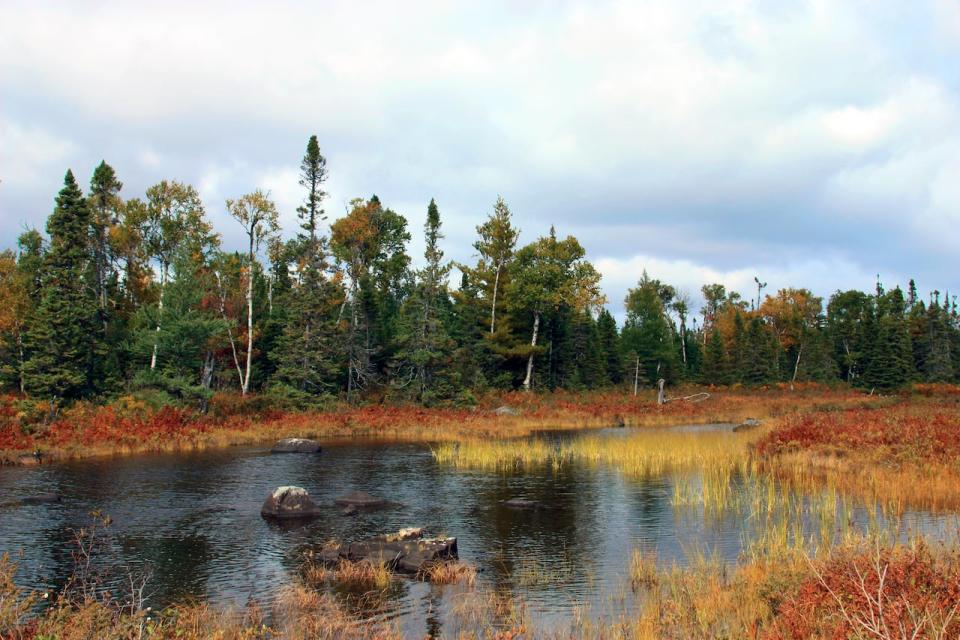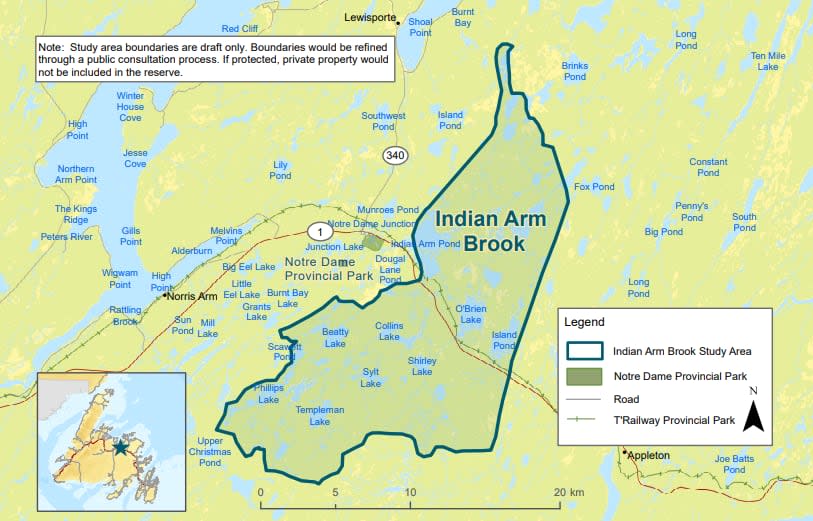More wilderness could be protected in N.L., and the province's prospectors say enough is enough


The area around Indian Arm Brook in central Newfoundland is under consideration to become a protected area. (Erika Pittman/Wilderness and Ecological Reserves Advisory Council)
If there's anything that can rile up an outdoor enthusiast in Newfoundland and Labrador, it's a discussion about what you can or cannot do in the province's wilderness.
Everyone, it seems, has their own ideas about what should be allowed, and, this fall, people who look for minerals are putting out the message that they don't want any more protected areas.
Newfoundland and Labrador is exploring the idea of establishing new protected areas — which could take the form of wilderness or ecological reserves of varying sizes and levels of protection — in 10 different parts of the province.
Norm Mercer, president of the N.L. Prospectors Association, says the province can't afford to set any more land aside, because it's bad for business and the future of the province's mining industry.
The association says it wants to send a message to the provincial government about protected areas.
"We think it's the wrong approach and we should look at a multiple land use approach," said Mercer.
Not digging it
The Wilderness and Ecological Reserves Advisory Council, a group of 11 volunteers appointed by the government based on their expertise, holds public consultations and advises government on protected areas.
The council says what it's been hearing from people in public consultations is that multiple land uses are a good idea when it comes to activities such as hunting, fishing and trapping. But the group said people are also saying they want the landscape in protected areas kept intact, which is something that prospecting and mineral exploration and development would not allow.
The group's focus at the moment is on a proposed protected area at Indian Arm Brook in central Newfoundland, with public meetings being held last week in Lewisporte and Norris Arm.
Council member Evan Edinger, a professor of professor of geography, biology and earth sciences at Memorial University, said it's not his place to counter or argue with anyone's views.
But he said what he's heard from other jurisdictions is that prospectors don't see much point in looking for minerals in a protected area where a mine will never be allowed.
"They want certainty," said Edinger. "If you open an area to prospecting and then say, 'Well, we're going to let you prospect but, if you find anything, we won't let you mine it,' then that isn't necessarily in the best interest of the prospectors and the prospectors association."

This map from the provincial government website shows the draft boundary of the Indian Arm Brook proposed protected area in central Newfoundland. (Government of Newfoundland and Labrador)
Makes dollars and sense
The idea of protected areas in 10 more areas of the province is distressing to the prospectors' association, said Mercer, since at least half of the areas proposed for protection at the moment are either fully or partially staked by mineral claims or are already being explored.
"This is a major concern to our prospectors. It's a major concern to junior companies who've optioned some of these properties to other players," said Mercer.
"So these claims, which number in the tens of thousands, would be impacted significantly. I mean an investor is not going to put dollars into the ground to explore a prospect if they see that the area can be removed and you don't allow any further followup or activity."
At a time when the province desperately needs economic development, Mercer said, it only makes sense to see where mineral prospects will lead.
"This is an industry that can deliver thousands of highly skilled, well-paying jobs. It could help refurbish and make vibrant many communities in the province," said Mercer.

Evan Edinger, a member of the Wilderness and Ecological Reserves Advisory Council and a Memorial University professor, says prospectors want certainty in where they can and can't explore. (Krissy Holmes/CBC)
Money isn't everything
Edinger said the council's job is to listen to everyone and to take their views into consideration when it makes recommendations to the provincial government.
But he said it's important to remember the prospectors' association is an interest group advocating for its own economic interests.
"Yes, mining is an important part of our economy. Protected areas are also an important area of our economy," said Edinger, who mentioned outfitting as one industry that benefits from an intact landscape.
Wait and see
The Department of Environment and Climate Change says it will wait to hear back from the council before deciding on Indian Arm Brook or any of the other proposed protected areas.
CBC News asked the department for a response to the N.L. Prospectors Association's concerns.
In an emailed statement, the department said it's directed the council to collect feedback from the public, and people who are interested in the development of reserves should take part in the engagement process that is underway.
Download our free CBC News app to sign up for push alerts for CBC Newfoundland and Labrador. Click here to visit our landing page.


